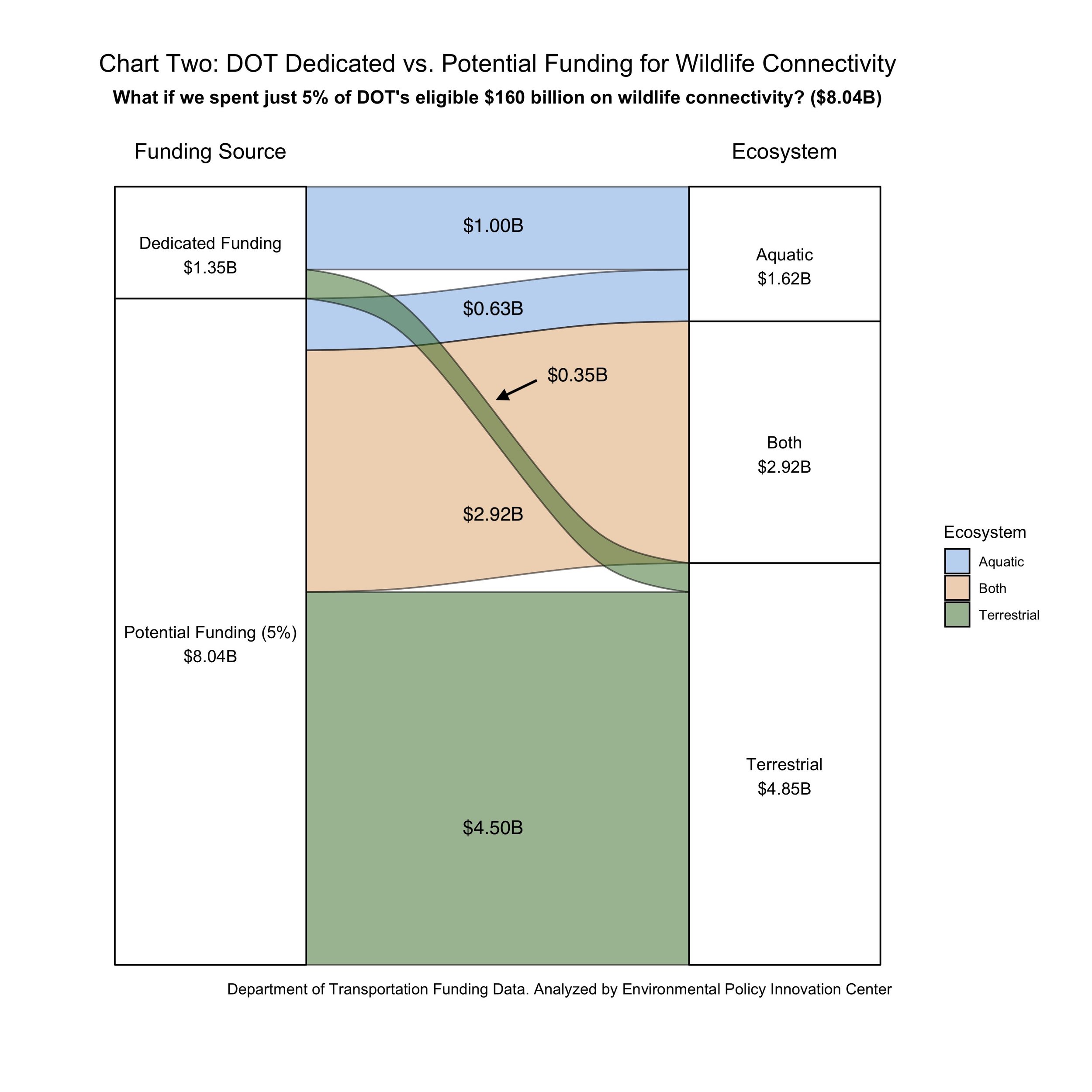Show Nature the Money: An argument for moving additional IIJA funding toward wildlife connectivity
Author Leanne Spaulding is Wildlife Connectivity Program Manager at EPIC
With two new sources of dedicated funding to help wildlife move, fishermen, tribes, nature-lovers, motorists, and outdoor sports enthusiasts have much to celebrate. And rightly so: these historic programs - the National Culvert Removal, Replacement, and Restoration Grant Program and Wildlife Crossings Pilot Program - took years of strategic advocacy, dedicated research, and technical expertise to make reality. Now, for the first time ever, $1.35 billion is committed to the sole purpose of mitigating some of the unintended environmental degradation and habitat fragmentation caused by transportation infrastructure, by letting fish swim upstream and moose cross highways.
As USDOT navigates the different stages of delivering these new programs, EPIC was curious to explore whether other opportunities lie waiting to be harnessed for furthering wildlife movement work. Specifically, we dug into the 15 other IIJA authorized grant programs administered by USDOT under which wildlife connectivity work is now eligible as components of comprehensive transportation projects such as bridge reconstruction. Table 1, below, lists the 15 programs - totaling $160.9 billion - with individual budget amounts to be dispersed over 5 years.
Table 1: Summary of Habitat Connectivity Funding Opportunities via Infrastructure Investment and Jobs Act
| Program Name | Amount (FY22-FY26) | Grant Type |
|---|---|---|
| INFRA | $8B | Competitive |
| Rebuilding American Infrastructure with Sustainability and Equity (RAISE) | $7.5B | Competitive |
| Rural Surface Transportation Grant | $2B | Competitive |
| Bridge Investment Program | $12.5B | Competitive |
| Tribal Transportation Program Safety Fund | $120M | Competitive |
| Nationally Significant Federal Lands & Tribal Project Program | $275M | Competitive |
| PROTECT (Federal) | $1.4B | Competitive |
| PROTECT (State) | $7.3B | State Formula Allocation |
| Bridge Formula Grant | $27.5B | State Formula Allocation |
| Highway Safety Improvement Program | $15.6B | State Formula Allocation |
| Surface Transportation Block Grant | $64.8B | State Formula Allocation |
| Transportation Alternative Program (TAP) | $7.2B | State Formula Grant |
| Federal Lands Access Program | $1.5B | State Formula Grant |
| Federal Lands Transportation Program | $2.2B | Federal Formula Allocation |
| Tribal Transportation Program | $3B | Tribal Formula Allocation |
Source: ARC Solutions, 2022.
Though wildlife connectivity and mitigation infrastructure are now eligible under these programs, integrating it into projects is not mandatory. Given this, we began to wonder: is there an opportunity to advocate for a voluntary threshold or percentage of program budgets to go toward integrated crossing, passages, and other wildlife-friendly structures?
Aside from the worthy outcome of more connectivity projects funded, pursuing a threshold for spending on wildlife consideration for these programs can yield other benefits. For example, a threshold may encourage greater transparency and tracking of formula allocation grants made by states to restore habitat linkage and migration corridors within their borders. Collection of state data can support ushering forth a framework to systematically measure the impact of these local investments at a national or regional-landscape scale. Equally important is that with more projects comes more opportunity to spur cost-saving innovations and support emerging technology, engage low-income communities and tribal nations, routinize the practice of making transportation projects wildlife-friendly from inception, and to collect vital data through long-term monitoring and evaluation programs. Data from a suitable sample size of projects strengthens the foundational argument for legislating or codifying the continuation or permanence of both the culvert and wildlife crossing pilot programs.
For example, a 5% threshold alone could yield over $8 billion more dollars toward combating fragmentation, honoring tribal treaty rights and giving wildlife - both aquatic and terrestrial - a fighting chance to safely traverse public infrastructure barriers and perhaps even outpace a number of climate change related threats. Chart 1 illustrates a general breakdown of USDOT infrastructure dollars and where a hypothetical 5% could be focused toward connectivity work. Notably, $8 billion is also roughly the price tag Americans shoulder yearly in vehicle damage, personal injury, and death from collision with large terrestrial mammals.
Though funding is focused slightly more on the terrestrial ecosystem, there could be much greater opportunity to fund fish passage projects beyond the $1 billion culvert program as well (see Chart 2). Roughly 13% of the potential funding dollars are eligible to aquatic ecosystem connectivity nested within larger infrastructure projects, and an additional 30% of the grants are eligible to both ecosystem types (see Chart 3). Overall, it seems there is potential to grow the impact that these funding programs have on migratory movement and connectivity, to ensure many more amphibians, reptiles, and mammals the safe passage they deserve.
The full details of this thought exercise and other recommendations for advancing habitat connectivity work can be found in our white paper: Moving Wildlife.




